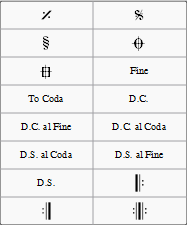Dấu lặp
The start and end of simple repeats can be defined by setting appropriate bar lines. For instructions on first and second ending measures, see Volta.
Playback
To hear repeats during playback, make sure the "Play Repeats" 
In the last measure of a repeat, you can set the property "Repeat count" to define the number of played repeats.
Repeat symbols and text
Text and symbols related to repeats are located in the Repeats palette.
The repeats palette contains the symbols for measure repeat, segno and coda. It also contains 'D.S.', 'D.C.', and Fine text:

To add an object from the repeats palette, drag it onto (not above) the desired measure (so the measure changes color), then drop. The object will then appear above that measure in your score.
Jumps
Jumps generally consist of three parts:
- Jump to tag
- Play up to tag
- Continue at tag
Tags are names you give to certain measure positions. Two tags ("start", "end") denote the start and end of the score and don't need to get added explicitly.
Examples:
At the jump instruction Da Capo the playback jumps to the start and plays the entire score again (up to the implicit end tag).
At the jump instruction Da Capo al Fine the playback jumps to the start and plays the score up to the tag Fine.
Dal Segno al Fine (or D.S. al Fine) jumps to the Segno tag and then plays up to the tag Fine
Dal Segno al Coda jumps to the Segno tag and then plays up the first Coda tag. Playback then continues at the second Coda tag. The properties of jumps can get set via a right-click at the D.S. al Coda tag.